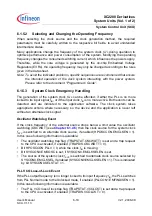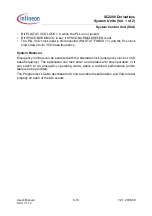
XC2200 Derivatives
System Units (Vol. 1 of 2)
System Control Unit (SCU)
User’s Manual
6-10
V2.1, 2008-08
SCU, V1.13
While the Prescaler Mode is used the Normal Mode can be configured and checked for
a positive VCO Lock status. The first target frequency of the Normal Mode should be
selected in a way that it matches or is only slightly higher as the one used in the
Prescaler Mode. This avoids big changes in the system operation frequency and,
therefore, the power consumption when switching later from Prescaler Mode to Normal
Mode. The P and N dividers should be selected in the following way:
•
Selecting P and N in a way that
f
VCO
is in the lower area of its allowed values leads
to a slightly reduced power consumption but to a slightly increased jitter
•
Selecting P and N in a way that
f
VCO
is in the upper area of its allowed values leads
to a slightly increased power consumption but to a slightly reduced jitter
After the P, and N dividers are updated for the first configuration, the indication of the
VCO Lock status (PLLSTAT.VCOLOCK = 1) should be awaited.
Note: It is recommended to reset the VCO Lock detection (PLLCON1.RESLD = 1) after
the new values of the dividers have been configured to get a defined VCO lock
check time.
When this happens the switch from Prescaler Mode to Normal Mode can be done.
Normal Mode is requested by clearing PLLCON0.VCOBY. The Normal Mode is entered
when the status bit PLLSTAT.VCOBYST is set.
Now the Normal Mode is entered. The trap status flag for the VCO Lock trap should be
cleared and then enabled again.
The intended PLL output target frequency can be configured by changing only the K2-
Divider. Depending on the selected divider value of the K2-Divider, the duty cycle of the
clock is selected. This can have an impact on the operation with an external
communication interface. In order to avoid too big frequency changes it might be
neccessary to change the K2-Divider in multiple steps. When the value of the K2-Diver
was changed the next update of this value should not be done before bit
PLLSTAT.K2RDY is set.
Note: The Programmers’s Guide describes a smooth frequency stepping to achieve an
appropriate load regulation of the internal voltage regulator.
PLL VCO Lock Detection
The PLL has a lock detection that supervises the VCO part of the PLL in order to detect
instable VCO circuit behavior. The lock detector marks the VCO circuit and therefore the
output
f
VCO
of the VCO as instable if the two inputs
f
REF
and
f
DIV
differ too much. Changes
in one or both input frequencies below a level are not marked by a loss of lock because
the VCO can handle such small changes without any problem for the system.
PLL VCO Loss-of-Lock Event
The PLL may become unlocked, caused by a break of the crystal or the external clock
line. In such a case, a trap is generated if the according trap is enabled. Additionally, the
clock
f
R
is disconnected from the PLL VCO to avoid unstable operation due to noise or






























